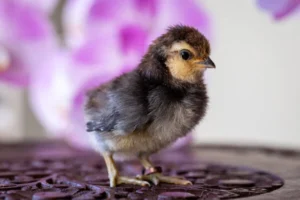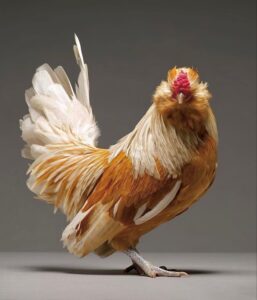Exploring the Charm of Barbu de Watermael Chickens: A Complete Guide
Discover the fascinating history of the Barbu de Watermael chicken breed, a cherished gem among poultry enthusiasts. Originating from the Watermael-Boitsfort region of Belgium, these elegant birds have a storied past dating back to the early 20th century. Bred for their unique appearance and charming demeanor, These chickens have captivated hearts around the world with their distinctive characteristics and heritage.
Egg-citing Insights: Barbu de Watermael Eggs and Production
Size
Barbu de Watermael eggs typically range in size from small to medium
Color
Barbu de Watermael eggs come in an array of hues, including cream, tinted, and occasionally blue or green
Production per year
Barbu de Watermael hens are moderate layers, producing approximately 150 to 200 eggs per year
When do Barbu de Watermael chickens start laying eggs?
Barbu de Watermael hens typically begin laying eggs around 6 to 7 months of age. Their first eggs may be smaller in size, gradually increasing in both frequency and volume as they mature.
Australorp Chicken Breed Characteristics
Temperament Traits: Gentle Bantams of the Poultry World
Experience the gentle and affectionate nature of Barbu de Watermael chickens, known for their docile temperament and friendly demeanor. These sociable birds thrive on human interaction and make excellent pets for families and individuals alike. With their calm and amiable disposition, Barbu de Watermael chickens often enjoy being held and handled, forging strong bonds with their caretakers.
Taming Barbu de Watermael Chickens: Building Trust and Connection
Unlock the secrets to taming Barbu de Watermael chickens through patience, consistency, and positive reinforcement. Spend quality time with your chickens, offering treats and gentle handling to gradually earn their trust. With time and dedication, they can become affectionate and responsive pets, enriching the lives of their human companions.
Ideal Flock Size: Finding Harmony in Numbers
Discover the optimal flock size for Barbu de Watermael chickens, balancing companionship with space requirements. A small flock of 4 to 6 birds is typically recommended for backyard enthusiasts, providing ample room for social interaction without overcrowding. However, they can adapt well to larger flocks with proper space and management, ensuring a harmonious and stress-free environment.
Space Requirements: Providing Room to Roam
Ensure that your Barbu de Watermael chickens have access to ample space for exercise and exploration. Provide at least 4 square feet of coop space per bird, along with a secure outdoor run or free-ranging area for daily enrichment. Barbu de Watermael chickens enjoy scratching, dust bathing, and foraging, so providing plenty of space allows them to engage in natural behaviors and maintain their physical and mental well-being.
Social Dynamics: Getting Along with Peers
Explore the social dynamics of Barbu de Watermael chickens and their interactions with other poultry. These sociable birds generally get along well with their flock mates, displaying minimal aggression and forming strong bonds within the group. Introduce new chickens gradually, monitoring their interactions to ensure a smooth integration and fostering a cohesive flock dynamic.
Appearance Insights: Beauty in Every Feather
Marvel at the stunning appearance of Barbu de Watermael chickens, characterized by their petite size and intricate feathering. These birds boast a compact and well-proportioned body, adorned with a striking array of colors and patterns. From their elegant crest to their delicately feathered legs, Barbu de Watermael chickens exude grace and charm in every aspect of their appearance.
Feeding Barbu de Watermael Chickens: Meeting Their Nutritional Needs
Chick Starter Feed: Fueling Growth from the Beginning: Birth to 8 Weeks
- Starter Feed: Barbu de Watermael chicks hatch with voracious appetites and a need for specific nutrients to fuel their rapid growth. This specialized feed provides the necessary vitamins, minerals, and amino acids to support bone and muscle development, feather growth, and overall health.
- Protein Content: A high-quality chick starter feed, containing around 18% to 20% protein, is essential for their early development.
- Feeding Frequency: Barbu de Watermael chicks have voracious appetites and high metabolic rates, requiring frequent access to feed to support their rapid growth. Keep chick starter feed available to them at all times, allowing them to eat as much as they need to satisfy their hunger and fuel their growing bodies. This ad libitum feeding approach ensures that they receive the nutrients they need to thrive without any restrictions.
- Supplemental Heat: During their early weeks of life, Barbu de Watermael chicks require a warm and cozy environment to thrive. Providing supplemental heat, such as a heat lamp or brooder, helps maintain their body temperature and aids in digestion. Consistent warmth is crucial for their overall health and well-being, preventing chilling and promoting optimal growth and development.
- Fresh Water: In addition to their feed, ensure that fresh, clean water is readily available to Barbu de Watermael chicks at all times. Use shallow waterers to prevent accidental drowning, and change the water regularly to maintain cleanliness. Proper hydration is essential for their overall health and well-being, supporting proper digestion, nutrient absorption, and temperature regulation.
Transitioning to Grower Feed: Supporting Continued Growth: 8 Weeks to Point of Lay
- Grower Feed Introduction: Around 8 weeks of age, Barbu de Watermael chicks begin their transition from chick starter feed to grower feed. Gradually introduce grower feed to the chicks, mixing it with their starter feed to allow for a smooth transition.
- Protein Content: Grower feed contains slightly lower levels of protein, typically around 16% to 18%, compared to chick starter feed. However, it still provides the essential nutrients needed for continued growth and development.
- Feeding Schedule: Offer measured quantities of grower feed to your chicks, ensuring they have enough to eat without overfeeding. Monitor their appetite and growth closely, adjusting feeding amounts as needed to prevent wastage and maintain healthy growth. A balanced diet supports their overall health and well-being, setting the stage for successful egg production in the future.
- Healthy Treats: In addition to their main feed, Barbu de Watermael chickens can enjoy a variety of treats and supplements to enhance their diet and provide additional nutrition. Offer small amounts of fresh fruits, vegetables, and herbs as occasional treats, ensuring they are chopped into manageable pieces to prevent choking. Additionally, consider providing supplemental sources of protein such as mealworms or scrambled eggs to boost their dietary protein intake, especially during molting or periods of increased energy expenditure.
Preparing for Egg Production: Transitioning to Layer Feed: Point of Lay Onward
- Layer Feed Transition: As Barbu de Watermael chickens approach the point of lay, typically around 18 to 20 weeks of age, it’s time to transition them to layer feed. Layer feed is specially formulated to meet the increased nutritional demands of laying hens, providing higher levels of calcium and other nutrients essential for egg production. Choose a layer feed with a protein content of around 16% to 18% and ensure it contains added calcium for strong and healthy eggshells.
- Calcium Supplementation: Offer free-choice calcium supplements such as crushed oyster shells or limestone grit to ensure the hens have access to additional calcium as needed.
- Feeding Routine: Maintain a consistent feeding routine, offering layer feed and calcium supplements to your Australorp hens regularly. Keep a close eye on their egg production and adjust feed quantities as needed to support optimal laying performance.
Special Feeding Considerations for the Barbu de Watermael
During molting, chickens may require additional nutrients to support feather regrowth and overall health. Consider supplementing their diet with higher protein feeds or specific supplements designed to support feather development. Similarly, during brooding, hens may benefit from additional calcium supplementation to support eggshell formation and reproductive health. Adjust their diet accordingly to meet their changing nutritional needs during these transitional periods.
Throughout the feeding process, it’s essential to monitor the Barbu de Watermael chickens’ appetite, growth, and overall health. Adjust feeding amounts based on their individual needs, ensuring they receive enough feed to support their growth and development without excess or deficiency. Regularly observe their behavior and body condition, making any necessary adjustments to their diet to maintain optimal health. Providing fresh, clean water at all times is also crucial to ensure proper hydration and digestion. By providing a balanced and nutritious diet tailored to each stage of their development, you can ensure the health, vitality, and egg-laying success of your chickens. Consistent access to quality feed, fresh water, and appropriate supplements is key to supporting their overall well-being and productivity throughout their lives.
Strengths and Weaknesses: Assessing the Barbu de Watermael Chicken
Evaluate the strengths and weaknesses of Barbu de Watermael chickens to better understand their characteristics and care requirements. Known for their gentle temperament, compact size, and charming appearance, these birds make delightful pets and productive egg layers. However, their smaller size may make them more susceptible to predators, requiring adequate protection and supervision. Understanding these qualities empowers poultry enthusiasts to provide optimal care and ensure the well-being of their chickens.
Embracing the Beauty of Barbu de Watermael Chickens
Barbu de Watermael chickens are a treasure trove of beauty, charm, and personality, enriching the lives of those who have the pleasure of raising them. From their rich history to their gentle temperament and striking appearance, these captivating birds continue to captivate poultry enthusiasts around the world. By providing attentive care, proper nutrition, and a nurturing environment, they will thrive and flourish, bringing joy and companionship to every flock they grace.


